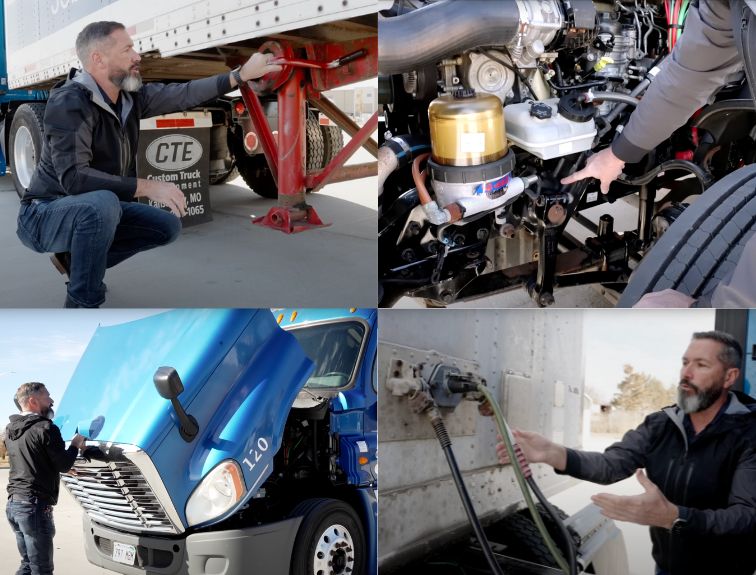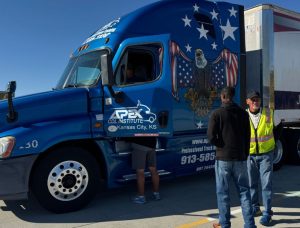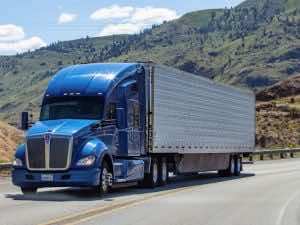
CDL Pre-Trip Inspection: Step-by-Step Guide
Tips for Missouri and Kansas CDL Test Takers
Preparing for your CDL exam? This ultimate pre-trip inspection guide walks you through every step, exactly as the state examiner expects from our CEO, Jeff Steinberg. Learn how to avoid automatic fails, master the brake check, and understand what’s changed in the new testing model. Additionally, we explain how testing works in Kansas and Missouri, as well as what you need to know about ELDT regulations.
JUMP TO SECTION:
Step-by-Step Pre-trip Checklist
Exterior Walk-Around Inspection
Full Pre-Trip Inspection YouTube videos
Pre-Trip Frequently Asked Questions
What Is a CDL Pre-Trip Inspection?
The pre-trip inspection is the essential starting point for every truck driver’s trip, ensuring safety and identifying any possible mechanical issues that could cause accidents or breakdowns during their route. It is also vital that CDL students master this skill because it is the first of three phases in the commercial driver’s license skills test. It’s designed to ensure you know all the steps for inspecting your truck and trailer before hitting the road.
The CDL exam is divided into:
1 – Pre-Trip Inspection
2 – Basic Vehicle Control (Backing)
3 – Road Test
The pre-trip phase checks your knowledge of:
- Safety equipment
- Truck and trailer components
- Air brake system
- In-cab controls
- Coupling system
Learn all of this with expert instructors in our Class A CDL Training Program »
What’s Changed in the New Modernized CDL Test?
As of 2023, many states, including Kansas and Missouri, have adopted a new CDL testing model developed by the American Association of Motor Vehicle Administrators (AAMVA) and the Federal Motor Carrier Safety Administration (FMCSA). It’s still thorough, but with a greater focus on safety-critical items.
Here’s what changed:
- Fewer required items to name/describe
- More streamlined checklist for examiners
- Standardized brake check procedures
- The entire truck is used in testing (no more A/B/C forms)
However, truck technology hasn’t changed much, so don’t assume it’s easier. You still need to know your stuff, especially if you’re testing in Kansas or Missouri.
Explore our CDL Study Guide for Kansas & Missouri »
Step-by-Step CDL Pre-Trip Inspection Checklist
Here is our comprehensive pre-trip breakdown, based on our YouTube video, which has garnered over 8 million views and is widely used across the industry. Combined and updated in 2024 to cover the modernized exam and follow the examiner’s official handbook, not just student materials. Our goal in sharing this content is to help anyone seeking to improve their safety, refresh their knowledge, or become a Commercial Driver.
In-Cab Inspection & Brake Check
Kansas requires the in-cab inspection first, because if you fail the brake check, the test ends there.

Safety Equipment
- Fire extinguisher: Rated 10 BC, fully charged, mounted
- Spare fuses (if required)
- 3 reflective triangles
Proper Entry Using 3 Points of Contact
Always maintain 3 contact points (hands/feet/handles). Failing to do this could be marked as unsafe.
Seat Belt
- Not frayed or damaged
- Locks properly and secure
Bonus points: remind the examiner to buckle up!
Lights with your Examiner
They’ll stand outside of the truck, and you will let them know which lights you are activating. You will ask them to check:
- Left/right turn signals
- Headlights
- Brights
- Hazards
- Brake lights (rear)
Safe Start & Gauges
- Foot on brake
- Transmission in neutral
- Key on: ABS light should turn on and off
- Start the truck
- Build air pressure to 120–140 PSI (listen for cut-off)
Gauge Checks
- Oil pressure rising
- Water temp gauge functioning
- Air gauges stable
- Voltmeter in normal range
Mirrors & Windshield
- Mirrors: Clean, adjusted, not cracked
- Windshield: No obstructions, cracks, or illegal stickers
If your truck has backup cameras or alternate monitoring systems, check that they’re functioning properly.
Windshield Wipers
- Blades not worn or cracked
- Arms secure
- Wiper fluid sprays
Heater & Defroster
Turn on both to verify they blow air.
Horns
Ensure the city horn and air horn are both working.
Parking Brake & Service Brake Tests
Parking Brake Check
- Tug test: Test tractor brake, then trailer brake separately.
Service Brake Check
- 5 mph roll then hard stop
- Watch for steering pull (uneven brake pressure)
Air Brake System (Four-Part Test)

Make sure the truck is in neutral. Shut off the engine, then key back on. Memory trick for air brake system check is SALE:
(S)tatic Test
No brakes applied. Don’t lose more than 3 PSI in 60 seconds.
(A)pplied Pressure Test
Brake applied. Don’t lose more than 4 PSI in 60 seconds.
(L)ow Pressure Air Warning
Fan brakes. The warning buzzer must sound at or before 55 PSI.
(E)mergency Brakes
Keep fanning. Tractor & trailer valves should pop between 20–45 PSI.
Exterior Walk-Around Inspection
Start with a general walk-around. Ensure the truck isn’t leaning, check for fluid leaks or hissing air sounds, and inspect for obvious damage before examining individual parts.
Memory Tricks
- CDL = Cracked, Damaged, Loose (metal parts)
- ABC = Abrasions, Bumps, Cuts (rubber parts)
- LLR = Lenses, Lights, Reflectors
Engine Compartment

- Engine oil (dipstick)
- Coolant level (sight glass)
- Power steering fluid
- Belts (not cracked or frayed)
Steering Components
- Shaft, gearbox, hoses
- No leaks, excessive play, or broken cotter pins
Suspension
- Leaf springs or airbags
- U-bolts tight, shock absorbers not leaking
Brakes and Tires (Front Axle)
- Brake hoses: No ABC
- Brake chamber: Not CDL
- Slack adjusters & push rods: Proper clearance
- Linings: Minimum ¼ inch
- Rims: No illegal welds
- Lug nuts: Tight, no rust streaks
- Valve stem: Not leaking
- Tire: 4/32” tread, no recaps on steer axle
Some trucks use airbags in the rear axle. If yours does, make sure you know how to inspect both systems.
Driver Side Inspection

- Battery box: Mounted, clean terminals
- DEF tank: No leaks, cap sealed
- Fuel tank: Secure straps, no leaks
- Frame: No bends, cracks, welds
- Mirrors: Secure
- Lights: Clean, correct color
Coupling Area
- Glad hands: No cuts or leaks, rubber intact
- Electrical cable: No exposed wires, plugs in securely
- 5th wheel: No gaps between apron and plate
- Locking jaws: Secured around kingpin
- Release arm: Engaged
- Safety latch: In place
Rear Axles, Trailer, and Final Checks

- Suspension: Airbags or leaf springs
- Tires: 2/32” tread depth minimum
- Brake components: Same as front
- Landing gear: Fully raised
- Doors & latches: Secure
- DOT bumper: Not damaged
- Mud flaps: Properly mounted
Inspect the entire vehicle, not just a form section (A, B, C).
CDL Pre-Trip Videos from Apex
How to Fail Your CDL Pre-Trip
To pass your CDL exam, you must earn a passing score based on naming parts and explaining what you’re checking for. You must meet the minimum threshold, but there are 3 ways to automatically fail:
Not Following Instructions
If you ignore the examiner’s directions or perform steps in a way that contradicts the official handbook.
Doing Something Unsafe
Examples include failing to use the three points of contact or improperly entering or exiting the cab.
Failing the Brake Check
If you don’t complete the air brake check exactly according to the state examiner’s instructions, it’s an automatic failure, even if the rest of your inspection is perfect.
Common Mistakes Students Make on the CDL Exam
Over the years, our team has witnessed thousands of students take their skills test after completing our four-week Class A CDL training program. Here are common mistakes students can make in each part of the CDL exam:
Most Common Mistakes on the Pre-trip Inspection
- Being vague with their terminology
- Skipping or rushing through items
- Failing to explain what they’re looking for (remember our memory tricks – CDL, ABC, LLR)
- Not checking fluid levels properly
- Inadequate tire inspection
- Missing safety equipment
Most Common Mistakes on Basic Vehicle Control
- Too many pull-ups
- Hitting cones or boundaries
- Going outside of the designated area
- Poor setup (ensure your truck is positioned correctly before you start your maneuver)
- Oversteering (this will cause the trailer to swing too far)
- Not using your mirrors (you must check all mirrors consistently during backing)
- Speed (if you back too quickly you will lose control of your position)
Most Common Mistakes on CDL Road Test
- Forgetting to signal
- Following distance (you must maintain 7 or more second gap)
- Poor observation
- Not checking mirrors enough
- Speed management
- Drifting lane positioning
- Automatic failures include: any collision or near-miss, running lights or signs, improper backing, speeding, dangerous lane changes, and blocking of intersections
CDL Pre-Trip Inspection FAQs
How many items do I have to name during the pre-trip inspection?
It varies by examiner, but generally, you must name enough to meet a minimum points threshold.
What happens if I miss a step of my pre-trip inspection?
You can still pass if your overall point total is high enough, but critical safety items must be done correctly.
Is it okay to do CDL pre-trip steps in a different order?
Yes, you can change up the order above as long as you cover all the listed items. Apex Technical Institute teaches students in this because it makes the most functional sense.
Can I take my CDL test at Apex Technical Institute?
Yes, if you train with us. We’re a third-party CDL testing site in Kansas.
What is ELDT (Entry-Level Driver Training)?
As of February 2022, all new CDL applicants nationwide must complete an FMCSA-approved ELDT program before they can take the skills test. If you skip this step or train at a non-registered provider, you won’t be allowed to take your CDL exam. At Apex, we are a registered ELDT provider. Our curriculum meets and exceeds all federal minimums by including extra practice time, modern training equipment, and instructors who stay updated on regulatory changes. Choosing the right school can be the difference between passing the exam the first time and having to retake it.
At Apex Technical Institute:
- We’re an FMCSA-registered training provider
- Our curriculum exceeds ELDT minimums
- You’ll get both classroom and hands-on training required by law
Learn more about the ELDT mandate »
CDL Testing in Kansas & Missouri: What to Know
Both Kansas and Missouri follow the updated CDL testing model. Whether you are from Kansas or Missouri, you can take your exam on-site with Apex since we are a state-approved examiner.
Taking your CDL exam with a third-party facility like Apex comes with a huge advantage: you already know the equipment, the yard, and the process. This familiarity goes a long way in reducing test-day nerves. At Apex, our testing site is certified by the state, and our examiners follow all official guidelines. Students often tell us how much more comfortable they feel testing in a setting where they’ve practiced. We even run mock exams that simulate the real test, so you can go in fully prepared.
CDL Test Day Tips
The night before your test, make sure you get a good night’s sleep. Spend the evening with your family or close friends and try not to focus on the exam. Avoid going out, and aim to get to bed early, even if your test isn’t until the afternoon. You want to be alert, calm, and ready to perform. Lay out the necessary items, including your valid Commercial Learner’s Permit (CLP), valid driver’s license, and a medical examiner’s certificate (this must be obtained electronically from the National Registry of Certified Medical Examiners).
On the morning of your test, take it easy on coffee, sugar, and nicotine. These can increase tension and cause nerves to increase. Instead, eat a light and balanced breakfast and ensure you are well-hydrated. Outfit recommendations include wearing long pants, a comfortable shirt, and study work shoes. Avoid loose jewelry or any accessories that could easily be caught on truck parts. Aim to arrive 20 to 30 minutes before your scheduled time. This will allow you to feel comfortable and mentally prepare for your exam.
Mental Preparation for your CDL Exam
- Take your time! (This is not a race. Go slowly and think through your actions before you perform them)
- Keep in mind the person testing you wants you to succeed
- Don’t focus on how many mistakes you can make and still pass
- Trust yourself and be confident in your education
Final Thoughts: Train Where the Experts Train
Passing the CDL pre-trip inspection takes more than just memorizing steps. You need to really understand how the vehicle works and get hands-on practice. That’s why our video has helped millions of people learn what to do, and our in-person program has helped thousands start new careers. Our instructors take their time to explain everything clearly, showing you what to look for and why each step is important for staying safe and following the rules.
Passing your Class A CDL exam is a huge milestone! It means you’re one step closer to launching your truck driving career. Many of our students secure jobs within a few weeks of graduating. CDL holders are in high demand across Kansas, Missouri, and beyond. From regional hauls to cross-country routes, entry-level jobs offer great pay, benefits, and stability.
Hear our graduates’ success stories:
A Truck Driver’s Journey of Resilience: Mohamad’s Story




